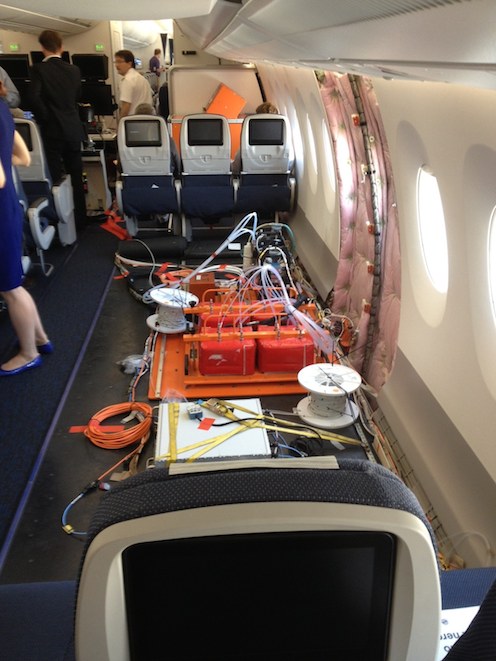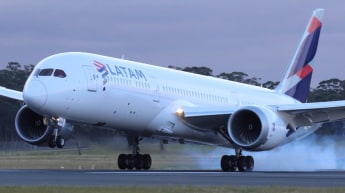A flight test program is a finely-tuned schedule, down to the most detailed demonstration and with every minute of flight time accounted for. The deadlines of certification and delivery loom ever closer as the engineers and pilots continue to put the aircraft through its paces. Still, last week, Airbus was able to somehow wedge a 60 minute flight into its A350 XWB timeline to showcase its newest family member to a media contingent visiting Toulouse for its ‘Airbus Innovation Days 2014’. I was fortunate to be one of those that flew aboard that flight.
The fact that Airbus was prepared to conduct the flight reflects two rather key points. Firstly, that its flight test program is on track and secondly, that it is confident enough in its product to take a load of media scribes aloft. Furthermore, Airbus created specific social media channels for the journalists to share the flight with the world. Consequently, there was a buzz of texting and tweeting as 200 passengers cleared a security channel and filed down the aero-bridge.
The aircraft’s cabin was still in flight test mode, so interspersed among the passenger seating were stations of data-gathering equipment, computer screens and cables taped to the floor. Even so, as one walked through business class and into the economy cabin there was still that new aeroplane smell. The interior boasted all of the mod-cons of inflight entertainment systems and even the fasten belt sign was a scrolling digital display. As we all settled in there was no mistaking that this was a new generation of passenger jet and we were very privileged to take flight.
Pushing back from the terminal I looked towards the wing-tip through generously sized windows. The winglet design is in itself interesting as it presents as a cross-over between a blended winglet and a raked wingtip. Its sweeping look is eye-catching, but more importantly it is there to offset the swirling vortices and aerodynamic drag.
Seated to the rear of the cabin, the noise levels generated as the engines started was negligible and was a trend that would continue throughout the flight. And while the Toulouse taxiways are undoubtedly smooth, the ride offered in the cabin was decidedly gentle both in terms of any bumps and braking. Combined with the comfortable economy seat it is obvious that the passengers’ well-being was premium in the design of the aircraft.
With only 30,000 kilograms of fuel on board, the lightly burdened A350 accelerated and soared into the air with a minimum of effort and sweet acceleration. Once again, I was struck by the low noise level in the cabin as the two Rolls-Royce Trent XWB engines spooled up and pushed the A350 skyward.
It took less than 15 minutes to climb to 31,000 feet and the pitch over into the level flight was smooth. When the thrust came back to cruise power, the cabin was comparable with the A380 as the quietest that I have encountered to date. That being said, I am yet to fly aboard the A350’s new generation of competitor from Seattle.
As we wheeled about the sky over Southern France, contrails criss-crossed the busy blue skies. Air traffic was everywhere to be seen, but none more spectacular than a Rafale fighter that approached to fly in loose formation with the A350. Below, the snow-capped Pyrenees highlighted the border between France and Spain as journalists moved from window to window with their cameras in-hand.
After nearly an hour and all too soon, the turn back towards Toulouse was forthcoming and the engines throttled back for descent. At one stage the Captain raised the speed-brake, not fully, but a little beyond half way. The panels left their flush positions on the wing’s upper surface but their was surprisingly little aerodynamic noise or buffeting generated by the flight spoilers.
The scene beyond the sweeping winglet soon changed from peaks to paddocks and then to the urban outskirts. Each stage of flap was deployed and the landing gear selected down until the aircraft was fully configured to land. The sound of the final ‘spool up’ of thrust was minimal and the touchdown as gentle as they come.
The test pilots had flown the aircraft impressively, but the aircraft was impressive in its own right. There is a good deal on offer to the passengers in both facilities and comfort, particularly in terms of the quiet cabin.
After I disembarked I was able to chat with the pilots about the A350 as we looked upon its clean white nose and ‘carbon fibre’ livery parked at the gate – but not for long. Soon the A350 was carrying a new crew and pushing back once more to continue the serious business of flight testing. I was left at sea level this time to contemplate the looming certification and entry into service of the A350 XWB.



















Bert Foster
says:“When the thrust levers came back to cruise power”
Owen, the thrust levers on an Airbus don’t move! The engines respond to FADEC control and can operate between IDLE and Max Continuous Thrust with the levers remaining stationary in the one detent. In a Boeing they move back at top of climb as the thrust levers follow the auto throttle commands. the only thing that moves on an Airbus is the gauges.
australianaviation.com.au
says:Text has been updated, cheers
Stu Bee
says:Little bit nit-picky…
Kevin L
says:Bert, the thrust levers have three detents at the end of the movement- climb, Max Continuous Thrust and TOGA (Take-off/Go Around). Normally, TOGA is selected for takeoff and then the thrust levers are brought back to the Climb detent during the climb. If I remember correctly, the throttles stay in this position until the pilot decides to either take manual control or go around. Max Continuous Thrust is designed for engine failures; if one engine fails at takeoff, the levers can be brought back to MCT for the other engine to remain at its highest continuous thrust setting.
Mark
says:I am sure it will be a quieter aircraft then the B787. Was not that impressed at all after all the hype. A380 still the quietest aircraft I have been on to date and look for to flying on the A350 to compare.
TrashHauler
says:I think everyone knew what Owen meant when he said thrust levers moving. Wow, let’s not rip the article apart on technicalities. Maybe the thrust levers DO MOVE on an A350, but I guess it wouldn’t be an Airbus if the pilot knew what was going on 🙂
Owen Zupp
says:Hi guys,
Firstly, thanks for reading the A350 piece. Secondly, my apologies for the technical oversight as I always endeavour to ‘get it right’. Thanks for bringing it to my attention, Bert. Funnily enough, I have been eating and breathing Airbus FADEC and Fly-By-Wire all week. I suspect writing the article at 4am local time allowed this turn of phrase to slip through to the ‘keeper. 🙂
Thanks again to everyone for your interest and support.
Cheers
Zuppie.